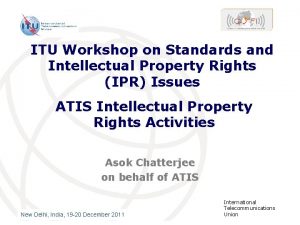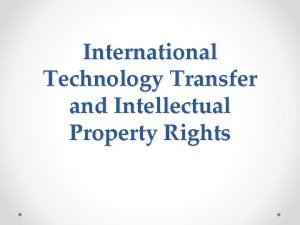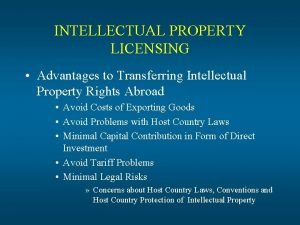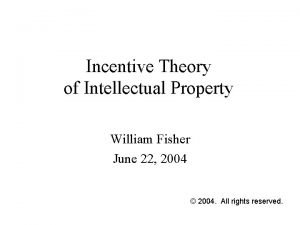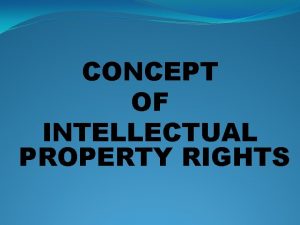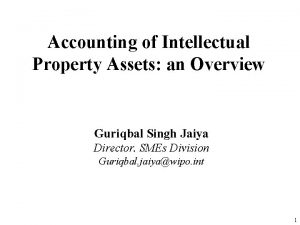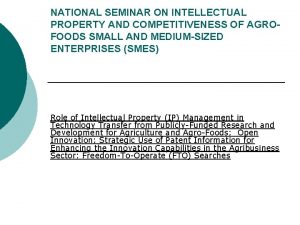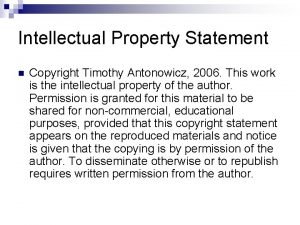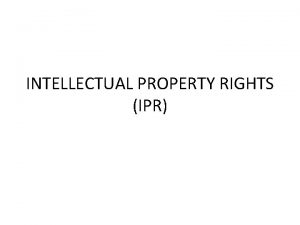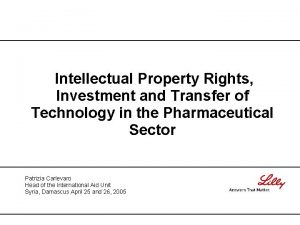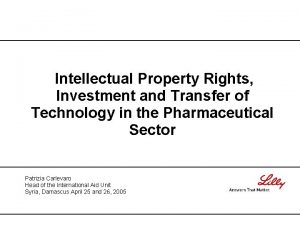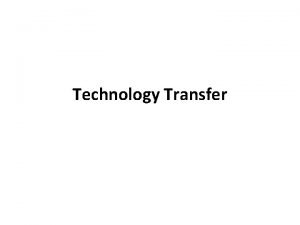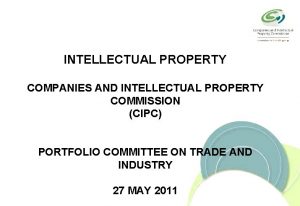International Technology Transfer and Intellectual Property Rights What























- Slides: 23

International Technology Transfer and Intellectual Property Rights

What is Intellectual Property? • Intellectual property (IP) refers to creations of the mind, such as inventions; literary and artistic works; designs; and symbols, names and images used in commerce. • IP is protected in law by, for example, patents, copyright and trademarks, which enable people to earn recognition or financial benefit from what they invent or create. By striking the right balance between the interests of innovators and the wider public interest, the IP system aims to foster an environment in which creativity and innovation can flourish.

What is Intellectual Property Rights? • Intellectual property rights are like any other property rights. • They allow creators, or owners, of patents, trademarks or copyrighted works to benefit from their own work or investment in a creation. • These rights are outlined in Article 27 of the Universal Declaration of Human Rights, which provides for the right to benefit from the protection of moral and material interests resulting from authorship of scientific, literary or artistic productions. • The importance of intellectual property was first recognized in the Paris Convention for the Protection of Industrial Property (1883) and the Berne Convention for the Protection of Literary and Artistic Works (1886). Both treaties are administered by the World Intellectual Property Organization (WIPO).

What is Intellectual Property Rights? • There are several compelling reasons for the protection of intellectual property rights: • First, the progress and well-being of humanity rest on its capacity to create and invent new works in the areas of technology and culture. • Second, the legal protection of new creations encourages the commitment of additional resources for further innovation. • Third, the promotion and protection of intellectual property spurs economic growth, creates new jobs and industries, and enhances the quality and enjoyment of life

Stance of Developed and Developing Countries on IPR • Developing countries are far behind developed countries in both acquired technology and domestically developed technology. • Furthermore, the lack of protection of intellectual property (IP), which governments of developing countries view as necessary to bring their economy and social welfare up to speed with the industrialized world, is at great odds with the goals and moral convictions of the developed countries. • Developing countries share a belief that industrialized countries wish to maintain their monopoly over advanced technology by demanding that developing countries implement strong intellectual property rights (IPR).

Stance of Developed and Developing Countries on IPR • Developed countries share a belief that an inventor deserves exclusive rights to their innovation. • Developed countries believe it is in their interest to protect the valuable technologies and intellectual property of their transnational companies (TNC) from being used or worse yet, copied, without compensation. • In their view, underdeveloped and developing countries engage in exactly those practices. • Thus, developed countries continue to push for a commitment from developing countries towards stronger protection of intellectual property.

International Protection of Intellectual Property • International Protection of Intellectual property rights are defined as governmental protection of private innovations and creativity. • The Paris Convention of 1883 and the Berne Convention of 1886 were the first international treaties on IPR. • The Paris Convention was created to ensure protection of industrial property. Ø This included patents, utility models, trademarks, and industrial designs. Ø It required member nations to treat both domestic and foreign patent holders and applicants equally. Ø However, it contained a loophole, in that it did not stipulate a minimum standard for such treatment.

International Protection of Intellectual Property • The Berne Convention is an international copyright treaty for the protection of literary, scientific, and artistic works. Ø It too, required equal protection for domestic and foreign copyright holders, but went further by describing minimum standards for such protection. Ø Notably, neither treaty protects recordings of sound.

World Intellectual Property Organization (WIPO) • In 1967, the World Intellectual Property Organization (WIPO) was created as a division of the United Nations. • It is charged with protecting and promoting intellectual property – via the Paris and Berne Conventions – throughout the world, as well as resolving international disputes over IP.

TRIPs • In 1994, under mounting pressure from the United States, Japan, and Europe, the Trade-Related Aspects of Intellectual Property Rights (TRIPs) Agreement was adopted at the Uruguay Round of the General Agreement on Tariffs and Trade (GATT). • TRIPs was established as an agreement under the newly formed World Trade Organization (WTO), and today, any nation wishing to join the WTO must comply with the standards set forth in TRIPs. • TRIPs defines minimum standards of protection for copyright, trademarks, patents, trade secrets, and contracts. • Furthermore, it requires a twenty year protection period for all inventions, products, and processes, in every area of technology. • Each member nation is required to comply with TRIPs by enacting national legislation. • January 1, 2006 was the deadline for all developing nations to comply with TRIPs, but many developing nations are not on track to meet this deadline.

TRIPs • To resolve disputes under TRIPs, countries are encouraged to engage in counseling and mediation meetings at the WTO. • If that fails, then the WTO will appoint an independent council of experts to review each country’s policy and make a recommendation. • Additionally, TRIPs allows members to impose trade sanctions on any member country which is in violation of the Agreement. • Thus, the dispute resolution mechanism is much stronger than that of the WIPO.

TRIPs • Despite the political clout of the developed countries, less developed countries (LDC) make up over 75% of the nearly 150 member body of the WTO and see membership as desirable because the benefits include preferred status as a trading partner with all of the other members. • In theory, all members are exactly equal in that each may cast one vote. Any legislation adopted by the Organization is the result of a consensus vote of the members. • In reality, the United States, Japan, and the European community seem to have the most influence in the WTO because they have power over underdeveloped countries in ways which are outside of the domain of the WTO

Developing Countries • Technology transfer is essential to all developing countries. • Developing countries do not possess a large amount of protected technology upon which they can build new technology and research. • Also, they lack a sufficient pool of trained personnel to perform research and development in new technologies. • Consequently, they need technology from developed nations to assist their growth. • The “Two Gap” Theory describes constraints limiting a developing country’s ability to gain technology.

Developing Countries Two-Gap Theory Ø First, developing countries are unable to save enough capital to create and maintain their own technological base to promote growth. Ø Second, the cost of importing technology far exceeds export (usually agriculture) revenues.

Developing Countries • If technology from developed countries is imported and protected too strongly, the developing country – the importer of technology – will not be able to lay its own technological groundwork. LDC view patents as inhibitors to technology transfer. • They bring about high fees for the use of beneficial technology and hinder attempts to foster the development of high technology industries domestically. • Additionally, because most patents are owned by corporations in the industrialized world, patents are regarded as instruments used by industrialized countries to exert control over the economic growth of developing countries.

Developing Countries • Aside from its effect on economic growth, LDC also argue that stronger patent protection will result in difficulty in providing access to drugs and other health items – due to higher prices. • This concern reflects the fact that LDC policies towards IP are guided by the idea of insuring access to technology directed to the basic welfare of its people. • The dire economic and social situations in many developing countries naturally gives rise to views that nobody should own knowledge, and that beneficial technologies should be easily spread amongst all people.

Developing Countries • Finally, there is the consideration of expense in creating a strong IP system in a developing country. • This expense is two-fold. Ø First, there is the expense of maintain the legal system to support enforcement of patents, copyrights, etc. This expense is joined with new training, which all judges and other legal personnel must receive to understand the new rights. Ø Second, pirating operations actually provide jobs and profits to a significant number of people and companies in developing countries. Ø The local government is often unwilling to put so many people in the community out of work

Developing Countries • • • By far, the most common way for developing countries to receive technologies from developed nations is via foreign direct investment (FDI) from transnational corporations. TNC will engage in such investing when it will provide an advantage not found in the home market of the TNC. However, as TNC move more production to developing nations where labor and infrastructure are cheap, they need stronger patent rights to ensure that their technology and knowledge do not leak into other companies in those countries. High tech industries, like computer software and pharmaceuticals, have high development costs and low imitation costs. TNC fear piracy, and this fear may cause a company to limit who it licenses its technology to in the developing country. The end result is that the TNC will not bring advanced technology to the LDC because of their weak patent and copyright protection.

Developing Countries • Consequently, many believe that if the LDC strengthen their protection of IP, they will see an increase in FDI. • Less developed countries need to absorb technologies and develop them in ways which exactly suit the problems they are trying to solve. • In this view, sometimes called indirect technology transfer, imported technology and domestic R&D are complementary. • It is essentially a form of Open Innovation. • The current policies will not help the developing countries grow out of complete dependence upon the technology of developed countries, in the long term. • Changes can be made, but only when the developed nations see the long term success of the developing nations as something which is in the best interest of all nations.

Developed Countries • Developed countries view IPR as a way of incentivizing innovation. • The way IPR are viewed is also a reflection of the western world’s views of property in general. • Developed countries argue that patents are essential to international economic development because they provide a means to guarantee a return on invested time and capital in R&D. • Thus, it is argued that TNC will be more likely to perform costly research, because a profit incentive will exist. • Additionally, developed countries feel that stronger IPR encourages R&D within the developing countries. • The developed countries argue that without strong protection of patent rights, scientists will leave the developing countries because their work will not be protected.

Developed Countries (TNCs) • From the perspective of the TNC, stronger intellectual property rights are a necessity for FDI. • The TNC are very fearful of the rampant piracy occurring in developing nations today. • At the same time, TNC know that they posses a lot of power because the developing countries desperately need modern technology. • Therefore, both the TNC and the developed nations in which they are located, argue that stronger IPR, particularly patent rights, in developing nations will attract more FDI.

Studies on IPR and Level of FDI • Edwin Mansfield conducted a survey of developing countries to discover whether a correlation exists between the strength of IPR and the level of FDI. • Mansfield found that stronger protection of IP will attract more foreign direct investment. However, the increase in FDI was observed to be largely limited to the areas of industrial chemicals, pharmaceuticals, and electrical equipment – including computers. • Additionally, the survey found that the increase in FDI occurred in R&D, rather than sales and distribution.

Studies on IPR and Level of FDI • Another survey which attempted to find the correlation between stronger intellectual property rights and the level of foreign direct investment, was conducted by Robert Sherwood. • His study found a positive correlation between stronger IP rights and FDI, in the form of R&D. • But his most important finding was that while the strengthening of IPR correlated with increases in FDI in the form of imported R&D (R&D performed by the TNC), no such correlation was found between stronger IPR and the level of domestic R&D. • This implies that attracting FDI – and consequently, technology transfer – solely by means of strengthened IPR is not a good long term economic strategy for a developing country because it will do nothing to build a domestic industry of high-tech R&D.
 Trade related aspects of intellectual property rights
Trade related aspects of intellectual property rights Intellectual property in professional practices
Intellectual property in professional practices Intellectual property rights
Intellectual property rights Intellectual property rights
Intellectual property rights Importance of intellectual property
Importance of intellectual property Intellectual property management definition
Intellectual property management definition Advantages of intellectual property
Advantages of intellectual property Intellectual property business plan example
Intellectual property business plan example Property
Property Right to intellectual property of teachers
Right to intellectual property of teachers Intellectual property definition
Intellectual property definition Theories of intellectual property william fisher
Theories of intellectual property william fisher Concept of intellectual property
Concept of intellectual property Valuation of ip
Valuation of ip Characteristics of intellectual property
Characteristics of intellectual property Discuss intellectual property frankly
Discuss intellectual property frankly Intangible inputs
Intangible inputs Intellectual property
Intellectual property Intellectual property statement
Intellectual property statement Intellectual property business plan example
Intellectual property business plan example Evalueserve competitors
Evalueserve competitors Discuss intellectual property frankly
Discuss intellectual property frankly At&t ecommerce
At&t ecommerce Positive vs negative rights
Positive vs negative rights


